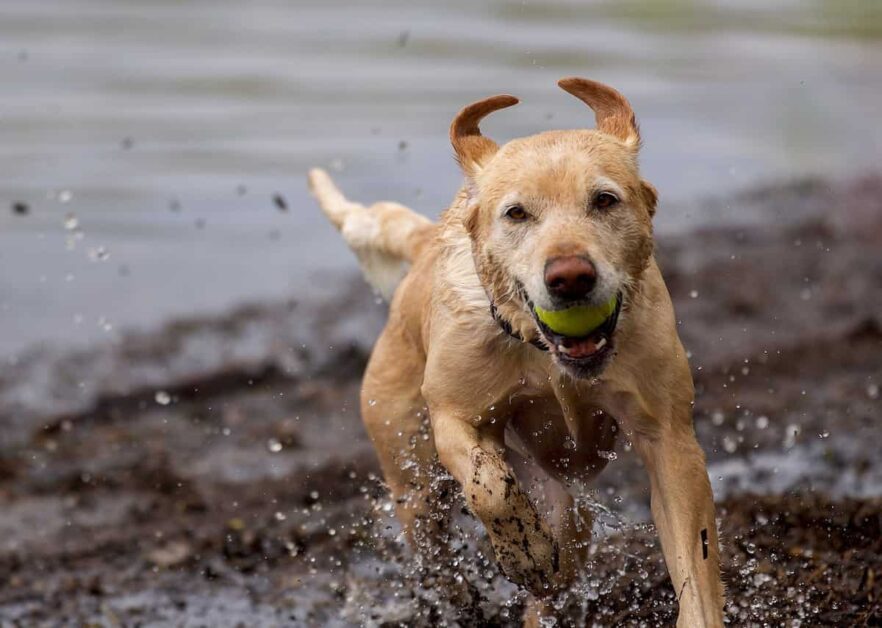Labradors have a double coat that provides insulation against cold weather. However, labs should not be left outside for extended periods in freezing temperatures. Limiting a lab’s time outside to 30 minutes or less when temperatures drop below 45 degrees Fahrenheit is best. Learn more about how long can a lab stay outside in the cold.
Prolonged exposure can put them at risk of hypothermia or frostbite. Provide a warm doghouse and fresh, unfrozen water if they spend any time outdoors in cold weather.

Do Labradors Get Cold in Winter?
Even though Labradors have a double coat that offers protection against cold, they still feel the chill in winter. Their breed originated from the icy regions of Newfoundland, where their ancestors worked alongside fishermen, giving them a natural affinity for colder climates.
However, a safe temperature range and duration exists for exposing your Labrador to freezing temperatures. If left outside in the cold beyond this limit, it could lead to health complications such as hypothermia or frostbite.
Cold origins of the Labrador Retriever
Labrador Retrievers come from a very cold place. This place is Newfoundland, Canada. It gets really cold there with frigid waters and winter conditions. In the past, Labradors had to swim in these icy waters often.
So they grew a thick coat that could keep the cold out. They can handle cold better because of this coat. It’s part of who they are now!
Double coat of a Labrador
Labradors have a short, thick coat that is water-repellent. This is known as the double coat. It’s key in helping them stay warm in cold climates. The top layer of the coat is straight and hard.
It helps to shield the dog from snow, ice, and water.
The underlayer of the Labrador’s coat is soft but dense and wooly. This acts like insulation for them. Even with this special double coat, Labradors can still get frostbite when it gets cold out.
Safe temperature range for Labradors
Labradors are strong dogs with a good cold weather tolerance. They can stay outside if the temperature is above 20 degrees Fahrenheit. Labs should be brought inside to stay warm and safe if it goes below that.
Puppies need even more care when it’s chilly outside. The safe zone for them is anything higher than 35 degrees Fahrenheit. Even though Labradors have thick coats, they still feel the cold when temperatures drop low enough.
Always keep an eye on your dog in wintry weather.
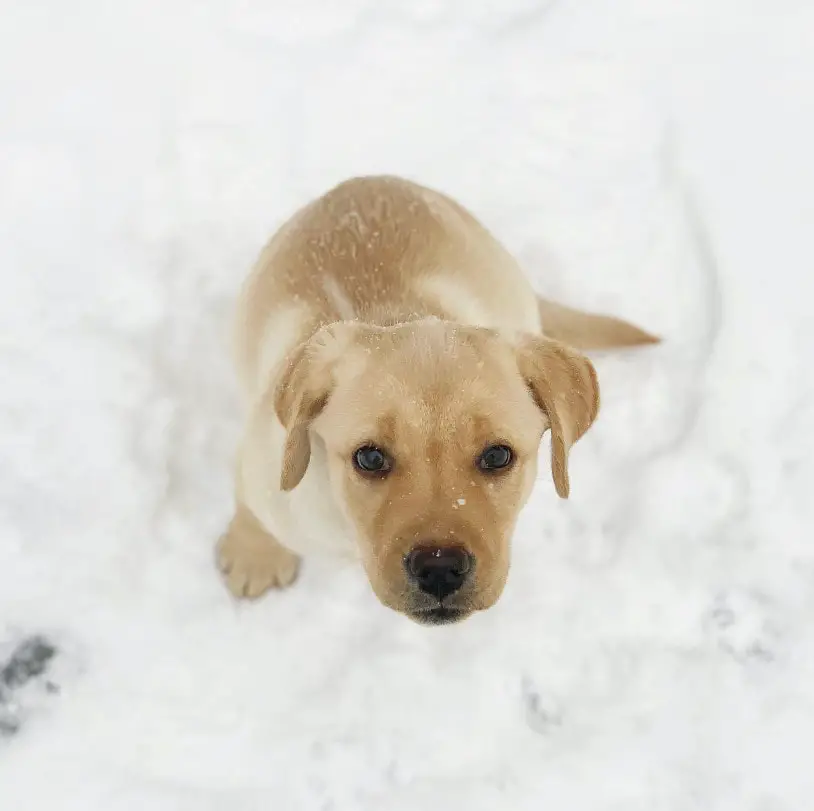
Why Labs Love the Cold Weather
Labradors are renowned for their love of cold weather due to their breeding history in wintry regions. Their double coat, including a dense undercoat that traps body heat, suits them well-suited to low temperatures.
More than just tolerating the cold, Labs have been known to enjoy winter activities such as snow fetching or swimming in chilly waters.
Bred for cold weather activities
Labradors come from a place with lots of cold weather. This place is called Newfoundland. It is why they can deal with cold well. They have thick fur that keeps them warm in the chill.
Their bodies are able to handle cold very well due to their cold-climate genetics. As part of this, they were made for tasks in freezing temperatures such as retrieving fishing nets through icy waters!
Tolerance for low temperatures
Labradors have a high tolerance for low temperatures. This is because their double coat keeps them warm in freezing weather. The top layer is short and thick to shield the dog from wind, rain, and snow.
The bottom layer is soft and fluffy to trap body heat.
Not all Labs can stay outside in the cold for a long time though. Labradors that are old or sick may feel cold faster than healthy young dogs. Keep your eye on your dog when it’s outside in winter.
It will tell you if it feels too cold by its actions.
Factors That Determine How Cold Is Too Cold for Labs
Several factors, such as age, health conditions, and individual resistance levels, can impact a Labrador’s cold tolerance. Older or sick dogs may find the cold more challenging, while healthy, younger Labs generally have stronger resilience.
Each dog is unique; hence, watching for signs of distress stemming from exposure to frigid temperatures is essential. It’s always best practice to consult a vet about your dog’s needs when dealing with winter weather.
Age of the dog
A dog’s age is a key factor in handling the cold. Puppies and old Labs can’t control their body heat as well as grown-up dogs. So, they should not stay outside for long when it’s cold.
Small dogs or those with thin coats can also face problems if they are outside in temperatures below 32°F (0°C). Each type of dog breed deals with the cold based on size, coat thickness, and color.
Hence, keeping them safe means providing a warm shelter for every Lab.
Health and medical conditions
Dogs with health issues can feel the cold more. Heart disease, kidney disease and diabetes make it harder for dogs to deal with the cold. Fat makes a dog warm, so skinny dogs lack this extra heat source.
Dogs rely on fur as well. Short or thin coats provide less warmth than thick fur does. Some dogs get sick more easily due to their medical condition. It can mean that they have a lower limit for what is too cold.
This underscores the need for owners to be mindful of their pets’ health status when it’s chilly outside.
Breed and individual tolerance
Labradors can handle colder weather thanks to their breed. They were bred for cold climates, so they have a sturdy coat that keeps them warm. Their double-layer coat lets them stay outside in temperatures above 20 °F (-7 °C).
This makes Labradors one of the more cold-tolerant dog breeds.
Each Labrador is different, though; some can stand the cold better than others. This is called individual tolerance. It means that while one Labrador might be okay in the snow, another could get too cold.
It’s important to watch your pet and check for signs they’re too chilly.
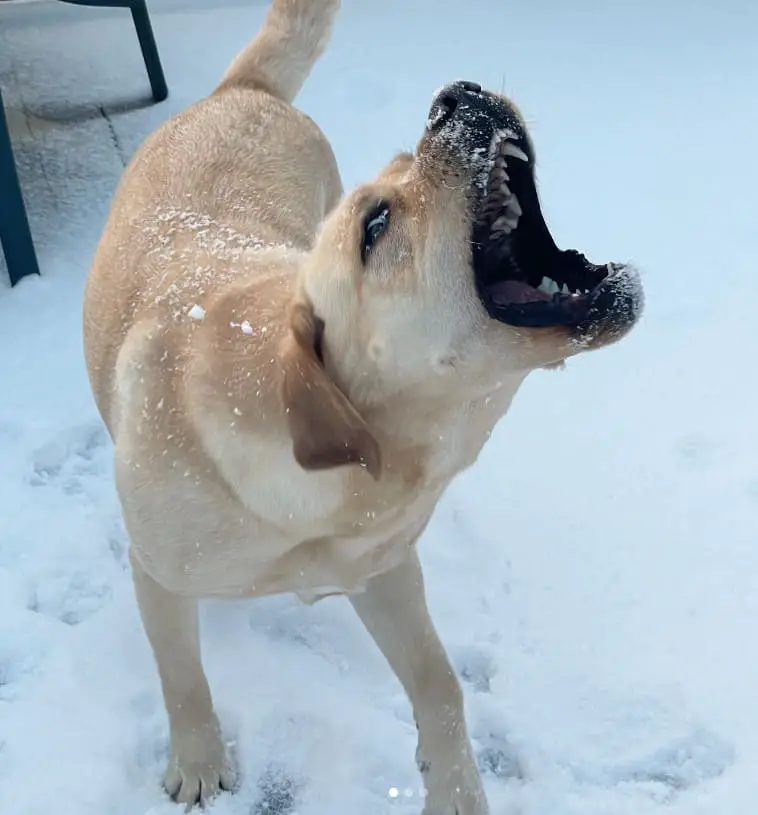
Can Labradors Tolerate the Cold Weather?
Despite their hardy nature and thick coat, Labradors do have a limit to the cold they can endure comfortably. Discover what signs to look out for when your Labrador is outside in chilly temperatures and learn the recommended temperature range that ensures their safety and well-being.
Recommended temperature range
Labradors can handle cold weather. But, when it gets very chilly, they need care. These dogs do well in temperatures over 20 degrees Fahrenheit. They don’t feel good if the mercury dips below this point.
Puppies find even 35 degrees too cold! Labs take time to get used to freezing conditions. It can take up to two months for them to adjust and be okay with icy winds and frosty weather.
However, each Lab is different! Coat thickness and health are important here too.
Signs that your Labrador may be too cold
You need to know if your Labrador is too cold. Here are some ways to tell:
- Your Lab shakes and shivers. This is a sign that they are feeling the chill.
- They start to move less. Labs have lots of energy, but when they’re too cold, they slow down.
- They try to find warm spots. Look for them under covers or in tight spaces.
- Their ears and paws feel cold if you touch them.
- Their gums and tongue may turn pale or blue.
- Your Lab might whine or whimper. This could mean that they’re not comfortable with the cold.
10 Things to Keep Your Labrador Warm Outside
Providing shelter and insulation
To keep your Labrador warm, you need a good shelter. A strong dog house helps block wind and rain. But that’s not enough for the cold. You should also use insulation. Insulation holds in warmth and keeps out the cold air.
There are many ways to insulate a dog house. One way is with straw or hay on the floor of the shelter. Another way is to put an insulated cover over the door entrance. Labradors have thick fur, which gives some protection but it won’t be enough in freezing temperatures or if your Labrador stays outside for too long, so give them extra help with these methods.
Using winter outdoor gear for dogs
Winter gear for Labradors helps them stay warm. Big dogs like labs may look tough, but they can get cold, too. Cold weather gear for dogs includes sweaters and coats. These clothes stop the wind and keep heat in.
Your lab will be able to play outside longer with these on. Warm clothing for dogs also keeps their skin safe from ice and snow. Always pick outdoor gear that fits your dog well. This means it’s not too tight or too loose.
Proper nutrition and hydration
Feeding your Labrador right is key in cold weather. A good diet will keep them strong and warm. Make sure their meals have the right balance of nutrients. This helps with temperature regulation and keeps them healthy during winter.
Water is also very important for Labs in cold climate health care, even when it’s not hot outside. Your dog still needs to drink a lot of water so they don’t get dry inside. Always keep fresh water out for them to drink whenever they need it.
Special Considerations for Dogs That Spend Prolonged Time Outside
If your Labrador spends a lot of time outside during winter, it’s crucial to know the risks of cold-related health issues and why regular veterinary check-ups are important.
Risk of cold-related health issues
Cold weather can cause health risks for dogs. A dog may get frostbite if it stays in the cold too long. Dogs that have heart disease, kidney disease, or diabetes can also get more sick from the cold.
If a dog’s body gets very cold, it could harm its organs and lead to death. This is called severe hypothermia. In the cold, dogs use energy fast, and their blood sugar decreases quickly.
This could also cause hypothermia. To keep your dog safe, ensure they have a warm place to sleep, like a good shelter with insulation and warm bedding.
Importance of vet checkups
Vet checkups play a key role in keeping outdoor dogs healthy. Cold weather can harm a dog’s immune system and raise the risk of viral infections. A vet sees this early and fixes it.
Dogs need a checkup once or twice a year for long, healthy lives. Good care from vets is needed for dogs who spend lots of time outside.
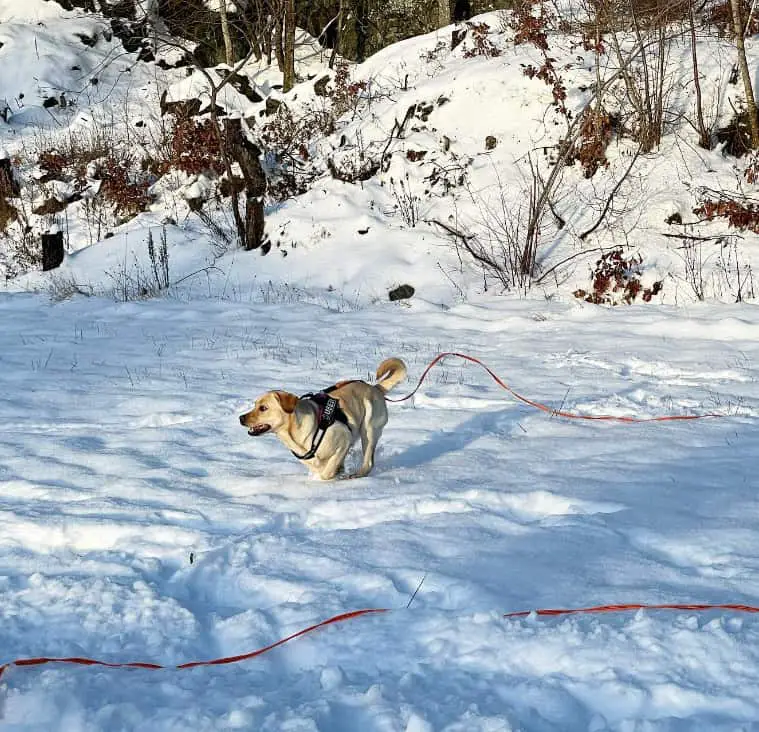
Dangerous Cold-Related Health Issues in Dogs
Hypothermia and frostbite are serious threats to dogs in frigid temperatures, but cold weather can also exacerbate arthritis, leading to joint pain and instigate respiratory infections.
Hypothermia
Hypothermia is a big problem for dogs in cold weather. It happens when a dog’s core body temperature drops too low. This can occur if Labs stay outside too long in the cold. The risk is high for small breeds as they can suffer from cold fairly faster than larger ones.
Existing health issues like kidney disease, heart failure, and diabetes mellitus can make this worse. These problems may lead to hypothermia more easily. Poisoning or trauma are other reasons that could cause it, too.
Hypothermia is not just bad; it harms your pet’s health if not dealt with immediately.
Frostbite
Frostbite is a serious problem for dogs in cold weather. It hurts the skin and other body parts when they get too cold. Dogs can even have lasting harm if frostbite gets really bad.
Extreme cold, wet conditions, or being out in the chill too long can make frostbite more likely. If your dog spends lots of time outside, watch out for signs of this dangerous health issue.
Arthritis and joint pain
Cold weather can make arthritis worse for dogs. This means more pain and stiffness in their joints. Many Labradors suffer from joint problems. As a result, they are at higher risk of getting arthritis.
Joint supplements might be the key to lessen this pain during cold months. These supplements bring down swelling and ease other symptoms of arthritis in your Labrador.
Respiratory infections
Labs facing cold weather deal with respiratory infections, too. Germs cause these problems and dogs feel ill for about 10 days. A dog might look bright and eat well even with a viral infection like canine influenza, which can live on surfaces for two days! Bacterial pneumonia and bronchopneumonia are other types of lung problems in dogs.
Labs may act tired, refuse food, or have trouble breathing when they have an infection in their lower lungs. Be sure to take your Lab to the vet if you see signs like these!
How to Create an Insulated Dog House for Your Labrador?
Discover practical DIY methods to make an insulated dog house for your Labrador, providing them with a cozy and warm refuge during cold weather. Discover more about these resourceful strategies by reading further.
DIY methods for insulating a dog house
You can make your Labrador’s dog house cozy and warm. Use rigid foam for insulation in the walls. You can use 1-1/2″ thick foam or glue-up foam boards. Foil-backed boards are best to keep heat in the dog house.
There are many other insulation options too, like fiberglass, reflective foil, bubble wrap and polystyrene foam. For tiny gaps and cracks, spray-expanding foam works well. This way you will keep your Lab warm in cold weather without electricity.
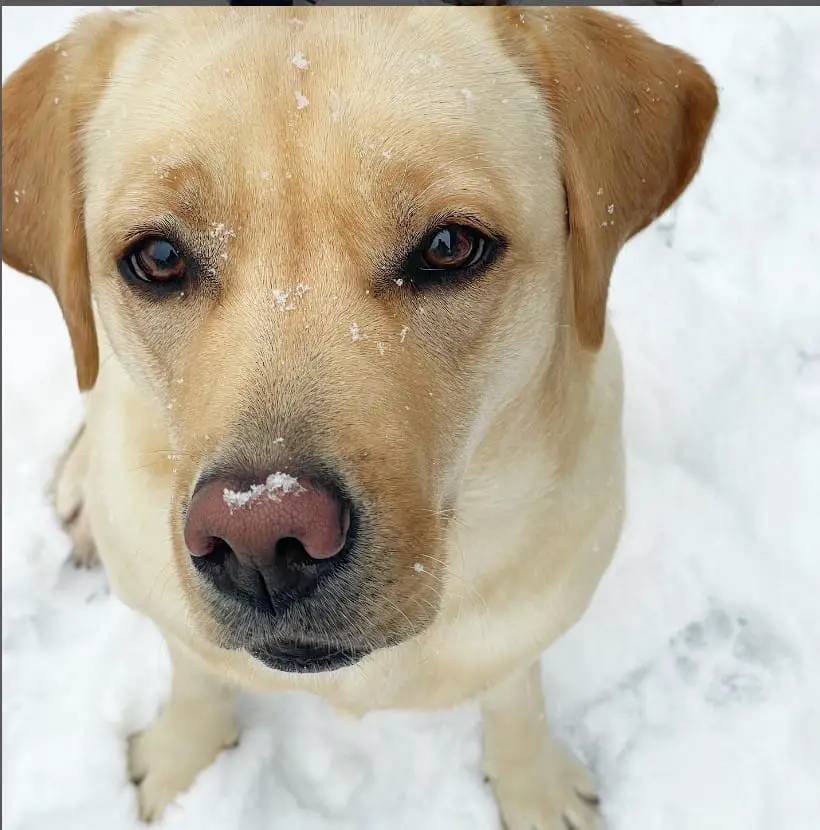
Conclusion
Labradors do well in cold weather. They have a thick coat that keeps them warm. But when it’s very cold, they need extra care. Always watch your Lab for signs of being too cold and take steps to keep them cozy and safe in winter times.
FAQs
1. How long can my labrador stay outside in the cold?
A healthy, adult Labrador can typically stay in the cold for about 30 minutes to an hour.
2. Can Labradors tolerate freezing temperatures?
No, Labradors should not be left outside in freezing temperatures as it could lead to frostbite or hypothermia.
3. Do I need to put a coat on my Lab in the winter?
Yes, putting a coat on your Lab during winters can help keep them warm when outside for brief periods.
4. Are all Labs able to withstand cold weather equally well?
No, puppies, old labs and ones with health issues may have problems staying warm even at mild temperatures.
5. When should I bring my lab back inside when it’s cold out?
You should bring your lab back inside if it starts shivering or acting distressed while being outside in the cold.
Author Profile

- Product Reviews Specialist and Cofounder
-
Labradors have an extraordinary capacity for love and companionship, and my mission is to help you unlock their full potential. Hi there! I'm Sarah, a proud contributor to Labradorandyou, the go-to online resource for all Labrador Retriever enthusiasts. As a lifelong owner and avid admirer of these remarkable dogs, I bring a wealth of knowledge and hands-on experience to our readers.
One of my strongest beliefs is in the power of positive reinforcement training. I'm truly passionate about helping our readers build strong, positive relationships with their Labradors. Whether you're a first-time owner or a seasoned Labrador enthusiast, I aim to provide you with the resources and guidance to cultivate a bond that will endure a lifetime.
Also by the author
-
 Lab-TypesJuly 5, 20251xbet تحميل تطبيق مجاني على Ios و Android Apk
Lab-TypesJuly 5, 20251xbet تحميل تطبيق مجاني على Ios و Android Apk
-
 Lab-TypesJuly 4, 2025Attention Required! Cloudflare
Lab-TypesJuly 4, 2025Attention Required! Cloudflare
-
 seJuly 4, 2025Guide, Recensioner & Bonusar
seJuly 4, 2025Guide, Recensioner & Bonusar
-
 1xbet BangladeshJuly 4, 20251xbet App Bangladesh For Android Plus Ios
1xbet BangladeshJuly 4, 20251xbet App Bangladesh For Android Plus Ios
